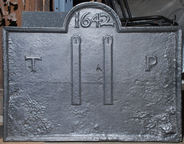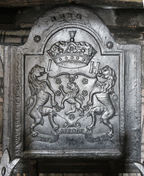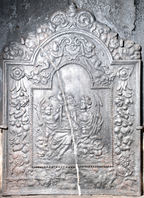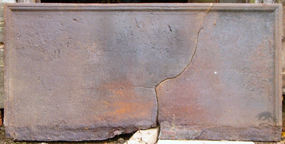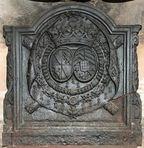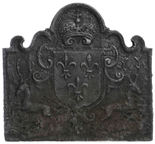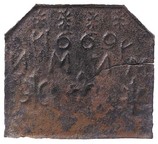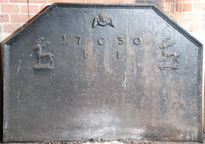-
217
Description: Arched rectangular shape; ovolo edging; date in arch; below arch, two parallel straps, each with a buckle at the top; initials left and right of centre; rectangular stamp with bird, four times across top.
Notes: The buckles, the date and the initials all appear to be separate stamps but attached to the base board before being impressed to form the mould, as they are identically positioned on all castings. The buckles suggest a connection with the Pelham family; the initials may relate to Sir Thomas Pelham, Bt. (1597-1654) who owned and operated ironworks at Waldron and Crowhurst in Sussex. This would appear to be a casting of the original pattern.
Copies of this fireback are known.
Inscription: 1642 / T P
- Decoration tags:
- rectangular with round arch (shape)
- ovolo (edging)
- whole carved pattern
- individual numbers
- planklines
- text
- objects
Manufactured: in 1642 probably at Waldron Furnace in the Weald area of England.
Current location: Brighton Museum and Art Gallery, Brighton, East Sussex, England.
Museum number: HA105912 (part of the Brighton Museum museum group)
Citation: Lindsay, J. S., 1927, Iron & Brass Implements of the English House (London, The Medici Society).
- Attached to series:
- 1642 Pelham series
- Pelham family firebacks
-
972
Description: Arched rectangular shape with ovolo-moulded edging and extensions to sides and top; central shield bearing arms with lion rampant supporters and motto scroll beneath; above, a marquesal coronet; date (over-pressed) in extension above main panel; inserted initials (slightly over-pressed) on either side of coronet.
Notes: The arms are of Henry Pierrepont, marquess of Dorchester and earl of Kingston-upon-Hull, of Thoresby Hall, Nottinghamshire (blazon: argent semi of cinquefoils gules, a lion rampant sable), with the motto: Pie Repone Te (Place yourself piously), a pun on the name, Pierrepont. Confusingly, the marquisate of Dorchester was created twice for members of the same family. In 1645 it was created for Henry Pierrepont, 2nd earl of Kingston-upon-Hull, becoming extinct on his death without surviving male issue in 1680. It was created again for Evelyn Pierrepont, the 5th earl of Kingston in 1706 who was subsequently elevated to the dukedom of Kingston in 1715. The original casting may therefore have dated to between 1645 and 1680 or between 1706 and 1715. The initials may be related to the Halls, the 2nd Duke of Kingston's mother's family, and were added to a subsequent casting which, in turn, could have pre-dated the addition of the dated extensions which have obliterated 'Dutch'-style dolphins known to have surmounted the original.
Inscription: 1722 / I H / PIE REPONE TE
Arms: Pierrepont, Marquess of Dorchester
- Decoration tags:
- rectangular with round arch (shape)
- ovolo (edging)
- whole carved pattern
- extension panels
- armorial
- text
Manufactured: in 1722 in England.
Current location: Red Lodge, Park Row, Bristol, England.
Museum number: NX420 (part of the Bristol Museums, Galleries and Archives museum group)
- Attached to series:
- Personal armorial firebacks
- Pierrepont series
-
1002
Description: Arched rectangular shaped central panel with bead edging; pictorial scene of a seated female figure resting against a hurdle, holding an anchor, a child on each side of her, the one on the left standing clutching corn stalks, the one on the right sitting also holding the anchor and a circular object; a bird sits on a post; arched rectangular border with bead edging; fructal and floral festoons suspended on ribbons with two putti at the top and two on each side; in the left and right bottom corners, the initials 'HH' and 'S' respectively; at the bottom, a central cartouche with date, between floral swags; on top, twin spirals between descending floral festoons.
Notes: The figure is an allegory of Hope. The theft in 1699 from a Thames-side warehouse of several firebacks, including '3 of Hope with an Anchor' may refer to this type (Post Boy 11-14 Nov. 1699). A recasting.
Copies of this fireback are known.
Inscription: [?H]H ...
- Decoration tags:
- 'Dutch' (shape)
- ovolo (edging)
- whole carved pattern
- pictorial
- allegorical
- text
- animals
- humans
- objects
Manufactured: in the mid-17th century in the Siegerland area of Germany.
Current location: Ashmolean Museum Broadway, 65 High Street, Broadway, Worcestershire, England.
(part of the Ashmolean Museum museum group)
- Attached to series:
- 'Dutch' HHS series
- Hope firebacks
-
621
Description: Rectangular; ovolo moulded edging (top and sides); central shield, crest and mantling of the Fuller family. The date, of which the 1 is not visible, is split between the top corners of the shield and about two-thirds of the way down.
Notes: A carved armorial on a plain, edged base board; the arms of the Fullers of Brightling Park, Sussex, are: Argent, three bars and a canton gules; the crest; Out of a ducal coronet Or, a lion’s head argent. The Fullers were iron masters and gun founders in the first half of the 18th century, operating Heathfield furnace, where it is likely that this fireback was cast.
Copies of this fireback are known.
Inscription: [1] 7 / 4 7
Arms: Fuller, of Brightling, Sussex
- Decoration tags:
- rectangular (shape)
- ovolo (edging)
- carved pattern panels
- heraldic
- armorial
- text
Manufactured: in 1747 probably at Heathfield Furnace in the Weald area of England.
Current location: in private hands, Butleigh, Somerset, England.
- Attached to series:
- Ironmasters armorial series
- Personal armorial firebacks
-
1070
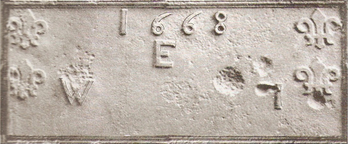 ? x ? mm
? x ? mmDescription: Rectangular; ovolo-moulded edging; two fleurs-de-lys arranged vertically top left and top right; top centre, date; below date, initials WEI in triad.
Notes: Said to have been made by George White, iron founder, of Monmouth. Formerly from Newport, Monmouthshire.
Inscription: 1668 / W E I [triad]
- Decoration tags:
- rectangular (shape)
- ovolo (edging)
- carved stamps
- individual letters
- individual numbers
- heraldic
- text
Manufactured: in 1668 possibly at Tintern Furnace in the Forest of Dean area of Wales.
Current location: National History Museum, St Fagans, Glamorgan, Wales.
Museum number: 25.21 (part of the Welsh National History Museum museum group)
Citation: Kissack, K., 2003, Monmouth and its Buildings (Almeley, Logaston Press).
- Attached to series:
- Miscellaneous stamp firebacks
-
856
Description: Rectangular; ovolo-moulded edging (top and sides); otherwise plain.
Notes: A base board, possibly used for other firebacks.
- Decoration tags:
- rectangular (shape)
- ovolo (edging)
- whole carved pattern
Manufactured: in the 16th or 17th century possibly in the Weald area of England.
Current location: in private hands, Chailey, East Sussex, England.
- Attached to series:
- Base boards
-
957
Description: Upon a rectangular base plinth, an arched rectangular, ovolo-moulded panel containing a draped cloth (disclosing on the reverse the arms of Duras) upon which two oval shields are surmounted by a ducal coronet, and encircled by the collars of the Orders of St Michel and Saint-Esprit. Behind the cloth are crossed batons of a Marshal of France; on each side are flattened S-scrolls with tassels.
Notes: In all probability the arms of Jean-Baptiste de Durfort, Duc de Duras (1684-1770), created Marshal of France in 1741.
Arms: Durfort, duc de Duras
- Decoration tags:
- rectangular with round arch (shape)
- ovolo (edging)
- whole carved pattern
- armorial
Manufactured: in the early- to mid-18th century in France.
Current location: Chateau de Duras, Duras, Lot-et-Garonne, France.
- Attached to series:
- Foreign armorial firebacks
-
824
Description: Rectangular with complex quasi-arched rectangular top; ovolo moulded edging; shield with Royal arms of France in a swirled cartouche; above, an English crown; below to right and left, a prancing stag.
Notes: The combination of the English crown and French arms is common and may relate to the marriage of Charles I and Princess Henrietta Maria of France in 1625; although the framing of the pattern is very similar to others of the same basic design, the style suggests a different pattern maker. Christie's auction 21 Jun 2011 lot 208 (£2,750).
Copies of this fireback are known.
Arms: France modern
- Decoration tags:
- rectangular with round arch (shape)
- ovolo (edging)
- whole carved pattern
- armorial
- animals
Manufactured: in the early- to mid-17th century possibly in the Weald area of England.
Current location: not known.
- Attached to series:
- Ornate border series
- Miscellaneous royal firebacks
- Anglo-French armorial firebacks
-
845
Description: Canted rectangle; ovolo-moulded edging (top and sides); from top: double star stamp repeated four times; date between two triads of the same initials, the 'Y' and the 'N' reversed; stylised fleur-de-lys below each pair of initials, with a large hollow fleur-de-lys in the centre.
Notes: The initials 'NYM' in triad probably relate to a couple whose surname initial was 'Y'; a fireback, dated 1659, with some of the same stamps is at the Dean Heritage Centre, Soudley, Gloucestershire, and another, dated 1667, has been noted at Upper End Farm, Hope Mansell, Herefordshire. Christie's auction, 24 May 2001.
Inscription: NYM [triad] 1669 NYM [triad]
- Decoration tags:
- rectangular with canted top corners (shape)
- ovolo (edging)
- carved stamps
- individual letters
- individual numbers
- heraldic
- text
Manufactured: in 1669 in the Forest of Dean area of England.
Current location: not known.
- Attached to series:
- Hollow fleur Dean series
- Newent area group
-
47
Description: Rectangular with canted top corners; ovolo-moulded edging (except base); top centre, cherub face and wings; below, date separated by initials in triad on either side of which a stag statant on a chapeau.
Notes: The cherub is similar, but not identical to those on a fireback, of 1713, from Ashburnham, and the layout and edging are also similar.
Inscription: 17 ICI [triad] 30
- Decoration tags:
- rectangular with canted top corners (shape)
- ovolo (edging)
- carved stamps
- individual letters
- individual numbers
- heraldic
- text
- animals
- humans
Manufactured: in 1730 possibly at Ashburnham Furnace in the Weald area of England.
Current location: in private hands, Cuckfield, West Sussex, England.
- Attached to series:
- Miscellaneous stamp firebacks
